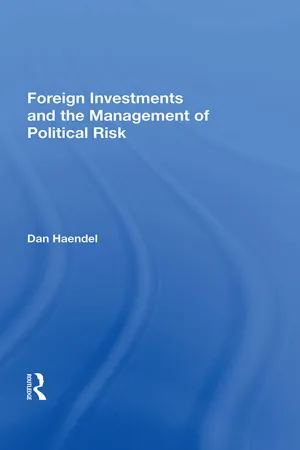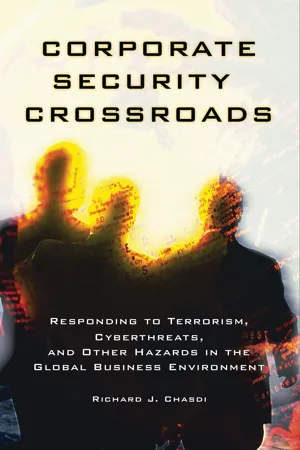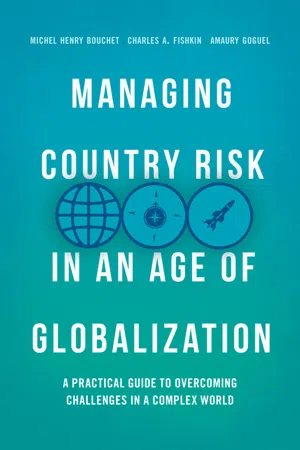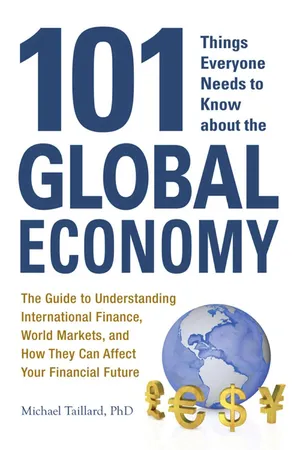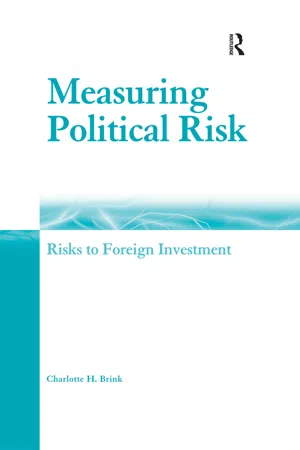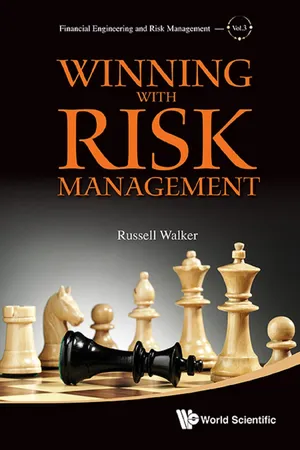Business
International Risk
International risk refers to the potential for adverse events or uncertainties that arise from engaging in business activities across national borders. These risks can include political instability, currency fluctuations, legal and regulatory differences, and cultural challenges. Businesses must carefully assess and manage international risks to protect their investments and operations in foreign markets.
Written by Perlego with AI-assistance
Related key terms
9 Key excerpts on "International Risk"
- Dan Haendel(Author)
- 2019(Publication Date)
- Routledge(Publisher)
3Political Risk: Identifying and Defining the IssueInternational corporate executives face governmental institutions and a variety of risks that distinguish their task from that of domestic corporate executives. Many view political risk in terms of government interference, through specific acts or events, with the conduct of business or in terms of overall government policy and attitude toward foreign investors. The international corporate executive is likely to view the international and host country environments as adding additional and difficult dimensions to the conduct of business operations. The increasing role of governments in the regulation of business justifies this perception.Identification and Assessment of “Political Risk”
A general awareness of the political risk problem has stimulated a variety of efforts to understand and deal with its complexity. For some, political risk is best illustrated by “politically caused” losses—for example: “(1) confiscation of property without adequate compensation, (2) damage to property or actions against personnel, (3) governmental interference with the terms of privately negotiated contracts, (4) bans on remittances of currency, and (5) discriminatory taxation or other arbitrary requirements on the firm.”1Others, however, may search for the fundamental cause of these losses and point to a factor such as political instability. Having isolated this factor, they may then focus on the familiar trilogy of various social, political, and economic factors as tending to cause instability: “(1) strong internal factions (religious, racial, language, tribal, or economic), (2) social unrest and disorder, (3) recent or impending independence, (4) new international alliances and relations with neighboring countries, (5) forthcoming elections, (6) extreme programmes, (7) vested interests of local business groups, and (8) proximity to armed conflict.”2- eBook - ePub
Rethinking Political Risk
Concepts, Theories, Challenges
- Cecilia Emma Sottilotta(Author)
- 2016(Publication Date)
- Routledge(Publisher)
By definition, any state that displays dissimilar characteristics represents a political risk and the possibility of instability” (p.15). Nonetheless, the political and economic upheaval that has followed the 2008 financial crisis has proven not only that Western, liberal democratic and capitalist countries are not free from political risks to foreign investors, but, on the contrary, that they can indeed generate such risks – for instance, failing to introduce and enforce effective mechanisms for financial governance. In sum, political risk could be defined as the probability that the profitability of an investment may be negatively affected by circumstances ascribable either to adverse unforeseen changes (such as revolutions, even when linked to democratization processes, or the outbreak of tribal/ethnic conflict) in the domestic or international political arena, or to governmental policy choices affecting an international investor’s property rights. In both cases, risk analysis would need to be conducted by carefully looking through the twin lenses of domestic political regimes on the one hand and of international factors on the other. In particular, the role and operationalization of the second aspect deserve a closer look. As explained in more detail below (see Chapter 3), while some have conceptualized the ‘external’ or international dimension of PR in terms of ‘bad neighborhood’, 8 further reflection is certainly needed in order to reach a more refined understanding of such a dimension. 2.2 Open questions Although they largely reflect the extant literature on the subject, none of the five groups of definitions listed above explicitly elaborates on the dyadic nature of political risk. Table 1.2 illustrates the idea that PR arises from the interaction of the specificities of an international firm with the specificities of a host country. 9 Elements such as the industry 10 within which a company operates or its size have an obvious impact on risk calculations - eBook - ePub
Corporate Security Crossroads
Responding to Terrorism, Cyberthreats, and Other Hazards in the Global Business Environment
- Richard J. Chasdi(Author)
- 2017(Publication Date)
- Praeger(Publisher)
5 In this book, the approach to risk is tied to the risk type Monahan calls “risk reduction,” where emphasis is placed on the reduction of explanatory factors and factor effects from a wide range of political, economic, and historical conditions found in particular operational environments and in the global environment.Monahan’s notion of “risk reduction” or “risk abatement” is different from “risk assessment,” with the latter producing specific probabilities about victimization risk, or the likelihood that people will pose a risk or potential risk to society.6 With Monahan’s notion of “risk reduction” in mind, one definition of “business security” as good as any is Spich and Grosse’s definition where, “business security can be defined as a defensive strategy and state of organizational readiness to assure and protect (but not guarantee) the functional integrity of the organization’s operational systems against purposeful, willful and intentional attempts by agents (inside or outside) to disrupt, damage, dismantle or destroy them.”7Although basic security concerns linked to multinational corporations are found in both the developed and the developing world, emphasis here is on multinational corporations primarily from the West and Japan, and increasingly China, that have offshore operations characterized by foreign direct investment in the developing world. That is the case because even though significant growth has occurred in multinational corporations from the emerging economies of Eastern Europe and the developing world, most multinational corporations still come from home countries in the developed world. It is those multinational corporations, primarily with their Western and Japanese executives, that are primarily vulnerable to political threats that derive from unresolved political problems. Kokaz-Muslu along with Jain and Grosse provide indications of the problem’s scope: Kokaz-Muslu asserts, “Approximately 80 percent of terrorist attacks against American interests over the past 30 years have been directed against American businesses.”8 Likewise, Jain and Grosse report, “Business should be concerned about terror-related risk, since 62% of terrorist attacks between 1999 and 2003 were targeted at businesses” (U.S. Department of State, 2003).9 - eBook - ePub
Managing Country Risk in an Age of Globalization
A Practical Guide to Overcoming Challenges in a Complex World
- Michel Henry Bouchet, Charles A. Fishkin, Amaury Goguel(Authors)
- 2018(Publication Date)
- Palgrave Macmillan(Publisher)
Model Risk : A Complex Challenge.)There are many other instances of uncertainty that can arise from a country’s political, economic, demographic, and cultural circumstances. They help illustrate the varied nature of Country Risk , as we explore further in Chapter 2 . For example:- Who will win the next leadership elections in Germany , France , and Italy ? What implications will these outcomes have for other countries in the Euro zone ?
- During the next year, which political regimes will falter or be subject to an attempted coup?
- What countries and cities will experience extreme weather conditions? What will be the impact on other countries and regions?
- Are there particular countries where the age of the population is changing faster than has been initially expected? If so, what are the consequences?
- What next technological innovation will fundamentally transform the way we work and live? In what country or countries will such innovation first emerge?
Box 1.1 Definitions of Risk
It is useful to examine how the term “risk ” has been used overtime by risk managers, risks advisors, regulators, and other practitioners. In some cases, these definitions limit the scope of risk to negative outcomes. In other cases, risk is also a source of opportunity.- International Organization for Standardization (ISO) : Risk is “the effect of uncertainty on objectives” (International Organization for Standardization 2009 ).
- Committee of Sponsoring Organizations of the Treadway Commission (COSO) :
- Risk is “the possibility that events will occur and affect the achievement of strategy and business objectives.”
- Uncertainty is “the state of not knowing how potential events may or may not manifest” (Committee of Sponsoring Organizations of the Treadway Commission 2017 ).
- Government of Australia : Risk is “the effect of uncertainty on objectives” where “an effect is a deviation from the expected, positive or negative” (Australian Government 2014 ). An enterprise framework developed for the US federal government uses a similar definition. See United States Chief Financial Officers Council and the Performance Improvement Council (2016 ).
- World Economic Forum : “A global risk is an uncertain event or condition that, if it occurs, can cause negative impact for several countries or industries within the next ten years” (World Economic Forum 2017
- eBook - ePub
101 Things Everyone Needs to Know about the Global Economy
The Guide to Understanding International Finance, World Markets, and How They Can Affect Your Financial Future
- Michael Taillard(Author)
- 2012(Publication Date)
- Adams Media(Publisher)
The risk in exchange rate fluctuation is that the currency of exchange loses value and you end up paying more or earning less than you had originally anticipated. Note that in the case of transaction risk, one person’s loss is very often the other person’s gain. As a result, foreign exchange risk holds both risk and potential. A company may analyze this risk (and many others) to either decrease the amount of loss they experience or increase the amount of revenues they earn.Companies trying to take advantage of foreign exchange fluctuations typically do so through asset management rather than attempting to do so through their purchases and sales. In other words, many prefer to maintain as little transaction risk as possible since the gain or loss on such foreign exchange fluctuations can be difficult to predict.Nations that have large, stable economies tend to be associated less with transaction risk. Of course, organizations that participate in significantly large international transactions will be at greater risk for even small changes in exchange rate; those nations with more stable fiat currencies—or currencies where the money derives its value from government regulation—usually experience less volatility.Why You Should Care
Except between two nations whose currencies are pegged directly to one another, transaction risk is an issue for every transaction that occurs across national borders. As a practical matter, since every time you buy anything, there’s a very good chance it was made, at least in part, in some nation other than your own, you’re directly affected by changes in the exchange rate.Most businesses that regularly transact business over multiple currencies account for the expected losses associated with this risk, or at least the costs of mitigating the risk. This is reflected in their pricing strategy, causing the price of the goods you’re purchasing to be somewhat higher.49. POLITICAL RISK
The role of a nation in the global economy is set, in large part, by the government in charge of that nation. The policies of that government define how the nation interacts with others, how companies participate in trade, and the degree of risk that organizations attempting to trade with that nation face. A change in government policy can greatly help or harm not only individuals or companies, but the entire global economy. - eBook - ePub
Measuring Political Risk
Risks to Foreign Investment
- Charlotte H. Brink(Author)
- 2017(Publication Date)
- Routledge(Publisher)
Chapter 6Managing Political RiskIntroduction
Investors put assets at risk to achieve their objectives and the analysis of these risks, including political risks, is a key to successful operations. Weighing up opportunities against potential losses becomes possible after an initial political risk assessment. Of course, the nature of risks an investor might face depends upon the project; the factors present in a host country’s investment climate that are associated with the project; cultural prevalence; and the individuals that make up the organization. Opportunities and risks are often a double-edged sword, and the management of political risks is but one of the challenges a Multinational Company (MNC) faces in a host country.A firm’s foreign investment strategy deals with the positioning of the organization in an uncertain host country environment and investment climate. As such, organizational strategic choices determine the size of a firm’s exposure to uncertain environmental and organizational components that impact on company performance. This chapter will attempt to explain how a firm’s political risk exposure (the sensitivity of a firm’s projected profitability and operationability in a host country to changes in the investment climate) can be managed and reduced.Formulating and designing a political risk policy as a means of managing political risk is a key point in this chapter. So far in this book, a lot of time has been spent on identifying, analyzing and measuring political risk. These are very important to any investor in finding the most viable investment opportunity and being aware of the political risks involved. Now that it has been shown that this can indeed be established, an investor can make decisions based on the ways in which the political risks in a chosen investment environment can be curbed or minimized, if not avoided. - eBook - ePub
- Adam Burgess, Alberto Alemanno, Jens Zinn, Adam Burgess, Alberto Alemanno, Jens Zinn(Authors)
- 2016(Publication Date)
- Routledge(Publisher)
Ulrich Beck (1986) notes that modern society increasingly produces potential dangers that are if not global then at least transnational. Beck goes on to note (1986: 64) that these increasingly global risks exist in a political and governance vacuum. There are few political institutions that are equipped to manage global risks because most political institutions are embedded in nation states.Risk and globalization
The concept of global risk has been discussed within many fields, including geography, sociology, political science and within branches of the field of risk management. There is little disagreement about the fundamental nature of global risk. The concept simply refers to risk of events that will have a negative impact on not only (individuals within) a single nation state, but also across nation states and will adversely affect a large number of people and other valuable entities. There is no exact definition stipulating the minimum number of affected people or extent of damage beyond ‘large’. The main point of analysing the global nature of such risks is not necessarily their scope – that is, their geographical extension in themselves – but rather the causes and implications of such geographical extension in relation to governance and management; however, the scope does often lend magnitude to risks when assessing them. Scope can, together with severity and probability, be used to characterize risk (Bostrom and Cirkovic, 2008: 3 ). The global nature of those risks is undoubtedly also a factor in various heuristic risk perceptions (to which we return later).Many global risks stem from technologies that are not linked to globalization. New multi-resistant strains of bacteria due to over-usage of penicillin, PFC gases (which deplete the ozone layer) or the risk of large-scale nuclear disasters are examples of risks that are certainly global in scale and are side effects of (the use of) technology, but which are essentially stemming from local use and production. Thus, in its most general sense, ‘global risk’ denotes risks that are global due to their extension, effects and implications but not their origins. As for the extensions, effects and implications (extensions should be obvious), they may create a greater awareness of global fragilities and of mutual co-dependence, or they may lead to new or expanded forms of transnational regulation and governance. Then again, they may also create fear and other defensive or hostile reactions to anything foreign. - eBook - ePub
Conquering Global Markets
Secrets from the World's Most Successful Multinationals
- N. Hubbard(Author)
- 2013(Publication Date)
- Palgrave Macmillan(Publisher)
Respondents were asked what were the key risks and challenges associated with going global. These were numerous and fell roughly into five key categories: political, economic/financial, market, people, and internal intangibles management. No respondents had a simple answer to this question—all foresaw that the risks and challenges were complicated, numerous, and interrelated.Political
Political risks and challenges included:Regulatory risks.Nationalism, including favoritism to state-owned or local companies.Government instability and the risk of nationalization.Corruption or the inability to operate fairly with local competition when not being corrupt.These risks were especially notable when entering the emerging world, although nationalism was seen as a key issue still in Europe. One respondent said, “For us I really think the two biggest challenges when going overseas are regulatory and nationalism—they are the two things that must stand out.” Related to nationalism was the perception of local bias against foreign companies, which was seen quite acutely especially when operating in China and India. One European said of operating in a regulated industry outside their home territory, “The biggest issue we have in operating [in that territory] is dealing with the fervent nationalism that puts us at an automatic disadvantage.” The frustration of having to compete with state-owned enterprises was apparent as indigenous competitors or those in partnership with Chinese or Indian companies were given preferential treatment over those considered “outsiders.” One participant commented:They’re not making it easy. Formally they say you will be treated in the same way as a domestic [company], but you cannot ignore that a country organization of a large international [player] will always be smaller than one who has India as his home country. After China not much can surprise you. I must say the only thing that surprises me here [in China] is the government is playing quite a large role awarding licenses. So, it’s not only up to the [regulators] but also the different ministerial departments [which] also have to clear it—there you always come into more political arguments. Let’s say bilateral relationships, treaties, as opposed to being judged on your own merits. - eBook - ePub
- Russell Walker(Author)
- 2013(Publication Date)
- WSPC(Publisher)
The linkage of risk to cost in origin and concept is profound for business. In business, risk does ultimately involve a cost, justified by an opportunity. Such risks are often encountered during a crisis or during a “shock” to the business. This connection of risk to crisis events or shocks that alter the underlying dynamics of a business is also a key concept and one that is nicely captured in the Chinese word structure for “crisis” which is taken from the combination of “danger” and “opportunity.” Danger and opportunity occur together in a crisis. Many great politicians over the years have recognized that a crisis also poses an opportunity. For a business, a crisis in an industry or market is also an opportunity. We will examine that concept more deeply throughout this book.Chinese characters for crisisAs we look to the financial and scientific communities for guidance on the word risk and its appropriate definition, we see that the concepts of likelihood and probability enter the concept of risk quite directly. Additionally, the impact of outcome of some probabilistic event is also a key concept. A common definition and enumeration of risk is the product of a probability (Pr) and an outcome:Risk = Pr × OutcomeAlthough the formula for risk is seemingly straightforward, the terms of likelihood and outcome may be well measured. Additionally in business, we are most concerned about making risk decisions about something that will happen in the future, so risk decisions are implicitly predictions, wrought with all the error that comes with making predictions.Risk and UncertaintyBusiness managers are faced with uncertainty and risk in every business venture. The famous American economist Frank Knight tells us that risk “incorporates more than uncertainty” and that risk (unlike uncertainty) is measurable to the business manager. Consider Frank Knight’s thesis in his seminal work, “Risk, Uncertainty, and Profit” (1921):Uncertainty must be taken in a sense that is radically distinct from the familiar notion of Risk, from which it has never been properly separated. The term “risk,” as loosely used in everyday speech and, in economic discussion, really covers two things which, functionally at least, in their causal relations to the phenomena of economic organization, are categorically different. The essential fact is that “risk” means, in some cases, a quantity susceptible of measurement, while at other times it is something distinctly not of this character; and there are far-reaching and crucial differences in the bearings of the phenomenon depending on which of the two is really present and operating. There are other ambiguities in the term “risk” as well. It will appear that a measurable uncertainty, or “risk” proper, as we shall use the term, is so far different from an unmeasurable one that it is not, in effect, an uncertainty at all. We shall accordingly restrict the term “uncertainty” to cases of the non-quantitative type. It is this ‘true” uncertainty, and not risk, as has been argued, which forms the basis of a valid theory of profit and accounts for the divergence between actual and theoretical competition.
Index pages curate the most relevant extracts from our library of academic textbooks. They’ve been created using an in-house natural language model (NLM), each adding context and meaning to key research topics.
